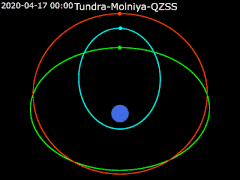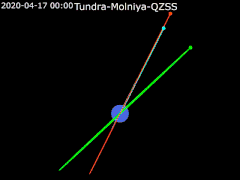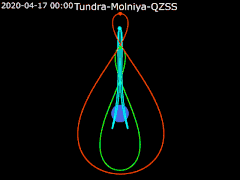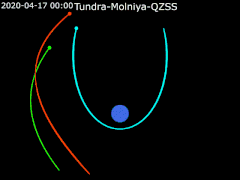Quasi-Zenith Satellite System
The Quasi-Zenith Satellite System (QZSS), also known as Michibiki (みちびき), is a four-satellite regional time transfer system and a satellite-based augmentation system development by the Japanese government to enhance the United States-operated Global Positioning System (GPS) in the Asia-Oceania regions, with a focus on Japan.[1] The goal of QZSS is to provide highly precise and stable positioning services in the Asia-Oceania region, compatible with GPS.[2] Four-satellite QZSS services were available on a trial basis as of January 12, 2018,[3] and officially started on November 1, 2018.[4] A satellite navigation system independent of GPS is planned for 2023 with 7 satellites.[5][6]
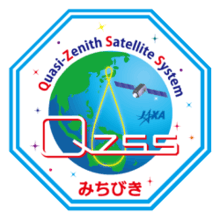 | |
| Country/ies of origin | Japan |
|---|---|
| Operator(s) | JAXA |
| Type | Civilian |
| Status | Operational |
| Coverage | Regional |
| Accuracy | PNT <10 m (public) SLAS <1 m (public) CLAS <10 cm (public) |
| Constellation size | |
| Total satellites | 4 (7 in the future) |
| Satellites in orbit | 4 |
| First launch | September 2010 |
| Orbital characteristics | |
| Regime(s) | 3x GSO |
| Other details | |
| Cost | JPY 170 billion |
| Website | qzss |


History
In 2002, the Japanese government authorized the development of QZSS, as a three-satellite regional time transfer system and a satellite-based augmentation system for the United States operated Global Positioning System (GPS) to be receivable within Japan. A contract was awarded to Advanced Space Business Corporation (ASBC), that began concept development work, and Mitsubishi Electric, Hitachi, and GNSS Technologies Inc. However, ASBC collapsed in 2007, and the work was taken over by the Satellite Positioning Research and Application Center (SPAC), which is owned by four Japanese government departments: the Ministry of Education, Culture, Sports, Science and Technology, the Ministry of Internal Affairs and Communications, the Ministry of Economy, Trade and Industry, and the Ministry of Land, Infrastructure, Transport and Tourism.[7]
The first satellite "Michibiki" was launched on 11 September 2010.[8] Full operational status was expected by 2013.[9][10] In March 2013, Japan's Cabinet Office announced the expansion of QZSS from three satellites to four. The $526 million contract with Mitsubishi Electric for the construction of three satellites was scheduled for launch before the end of 2017.[11] The third satellite was launched into orbit on 19 August 2017,[12] and the fourth was launched on 10 October 2017.[13] The basic four-satellite system was announced as operational on November 1, 2018.[4]
Orbit
QZSS uses one geostationary satellite and three satellites in Tundra-type highly inclined, slightly elliptical, geosynchronous orbits. Each orbit is 120° apart from the other two. Because of this inclination, they are not geostationary; they do not remain in the same place in the sky. Instead, their ground traces are asymmetrical figure-8 patterns (analemmas), designed to ensure that one is almost directly overhead (elevation 60° or more) over Japan at all times.
The nominal orbital elements are:
| Epoch | 2009-12-26 12:00 UTC |
| Semimajor axis (a) | 42,164 kilometres (26,199 mi) |
| Eccentricity (e) | 0.075 ± 0.015 |
| Inclination (i) | 43° ± 4° |
| Right ascension of the ascending node (Ω) | 195° (initial) |
| Argument of perigee (ω) | 270° ± 2° |
| Mean anomaly (M0) | 305° (initial) |
| Central longitude of ground trace | 135° E ± 5° |
Satellites
Current 4 satellite constellation
| Name | Launch date | Status | Notes |
|---|---|---|---|
| QZS-1 (Michibiki-1) | 11 September 2010 | Operational | - |
| QZS-2 (Michibiki-2) | 1 June 2017 | Operational | Improved solar panels and increased fuel |
| QZS-3 (Michibiki-3) | 19 August 2017 | Operational | Heavier design with additional S-band antenna on geostationary orbit |
| QZS-4 (Michibiki-4) | 10 October 2017 | Operational | Improved solar panels and increased fuel |
Future 7 satellite constellation
| Name | Planned Launch date | Status | Notes |
|---|---|---|---|
| QZS-1R | 2020 | Future | Replacement for QZS-1 |
| QZS-5 | 2023 | Future | - |
| QZS-6 | 2023 | Future | - |
| QZS-7 | 2023 | Future | - |
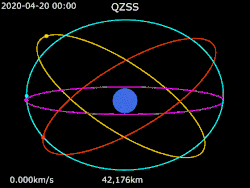
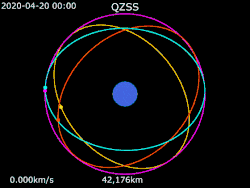

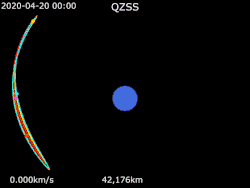
QZSS and positioning augmentation
The primary purpose of QZSS is to increase the availability of GPS in Japan's numerous urban canyons, where only satellites at very high elevation can be seen. A secondary function is performance enhancement, increasing the accuracy and reliability of GPS derived navigation solutions.
The Quasi-Zenith Satellites transmit signals compatible with the GPS L1C/A signal, as well as the modernized GPS L1C, L2C signal and L5 signals. This minimizes changes to existing GPS receivers.
Compared to standalone GPS, the combined system GPS plus QZSS delivers improved positioning performance via ranging correction data provided through the transmission of submeter-class performance enhancement signals L1-SAIF and LEX from QZSS. It also improves reliability by means of failure monitoring and system health data notifications. QZSS also provides other support data to users to improve GPS satellite acquisition.
According to its original plan, QZSS was to carry two types of space-borne atomic clocks; a hydrogen maser and a rubidium (Rb) atomic clock. The development of a passive hydrogen maser for QZSS was abandoned in 2006. The positioning signal will be generated by a Rb clock and an architecture similar to the GPS timekeeping system will be employed. QZSS will also be able to use a Two-Way Satellite Time and Frequency Transfer (TWSTFT) scheme, which will be employed to gain some fundamental knowledge of satellite atomic standard behavior in space as well as for other research purposes.
QZSS timekeeping and remote synchronization
Although the first generation QZSS timekeeping system (TKS) will be based on the Rb clock, the first QZSS satellites will carry a basic prototype of an experimental crystal clock synchronization system. During the first half of the two year in-orbit test phase, preliminary tests will investigate the feasibility of the atomic clock-less technology which might be employed in the second generation QZSS.
The mentioned QZSS TKS technology is a novel satellite timekeeping system which does not require on-board atomic clocks as used by existing navigation satellite systems such as BeiDou, Galileo, GPS, GLONASS or NavIC system. This concept is differentiated by the employment of a synchronization framework combined with lightweight steerable on-board clocks which act as transponders re-broadcasting the precise time remotely provided by the time synchronization network located on the ground. This allows the system to operate optimally when satellites are in direct contact with the ground station, making it suitable for a system like the Japanese QZSS. Low satellite mass and low satellite manufacturing and launch cost are significant advantages of this system. An outline of this concept as well as two possible implementations of the time synchronization network for QZSS were studied and published in Remote Synchronization Method for the Quasi-Zenith Satellite System[15] and Remote Synchronization Method for the Quasi-Zenith Satellite System: study of a novel satellite timekeeping system which does not require on-board atomic clocks.[16]
See also
- Global Navigation Satellite System (GNSS)
- Multi-functional Satellite Augmentation System (MSAS)
- Inclined orbit
- Tundra orbit
References
- "Quasi-Zenith Satellite Orbit (QZO)". Archived from the original on 2018-03-09. Retrieved 2018-03-10.
- "[Movie] Quasi-Zenith Satellite System "QZSS"". Quasi-Zenith Satellite System(QZSS). Archived from the original on 2017-07-15. Retrieved 19 July 2017.
- "[Notices] Start of QZS-4 Trial Service". Quasi-Zenith Satellite System(QZSS). Archived from the original on 2018-08-10. Retrieved 2018-05-02.
- ""Japan's QZSS service now officially available"". Retrieved 11 Jan 2019.
- "Japan mulls seven-satellite QZSS system as a GPS backup". SpaceNews.com. 15 May 2017. Retrieved 10 August 2019.
- Kriening, Torsten (23 January 2019). "Japan Prepares for GPS Failure with Quasi-Zenith Satellites". SpaceWatch.Global. Retrieved 10 August 2019.
- "Service Status of QZSS" (PDF). 2008-12-12. Archived from the original (PDF) on July 25, 2011. Retrieved 2009-05-07.
- "Launch Result of the First Quasi-Zenith Satellite 'MICHIBIKI' by H-IIA Launch Vehicle No. 18". 2010-09-11. Archived from the original on 2012-03-20. Retrieved 2011-12-12.
- "QZSS in 2010". Magazine article. Asian Surveying and Mapping. 2009-05-07. Retrieved 2009-05-07.
- "GNSS All Over the World". The System. GPS World Online. 2007-11-01. Archived from the original on August 23, 2011. Retrieved 2011-12-12.
- http://www.spaceflightnow.com/news/n1304/04qzss/ Archived 2013-04-11 at the Wayback Machine Japan to build fleet of navigation satellites 2013-04-04 Retrieved 2013-04-05
- "Archived copy". Archived from the original on 2018-08-09. Retrieved 2017-08-20.CS1 maint: archived copy as title (link)
- "Archived copy". Archived from the original on 2018-08-16. Retrieved 2017-08-20.CS1 maint: archived copy as title (link)
- Japan Aerospace Exploration Agency (2016-07-14), Interface Specifications for QZSS, version 1.7, pp. 7–8, archived from the original on 2013-04-06
- Fabrizio Tappero (April 2008), Remote Synchronization Method for the Quasi-Zenith Satellite System (PhD thesis), archived from the original on 2011-03-07, retrieved 2013-08-10
- Fabrizio Tappero (2009-05-24). Remote Synchronization Method for the Quasi-Zenith Satellite System: study of a novel satellite timekeeping system which does not require on-board atomic clocks. VDM Verlag. ISBN 978-3-639-16004-8.
- Petrovski, Ivan G. QZSS - Japan's New Integrated Communication and Positioning Service for Mobile Users. GPS World Online. June 1, 2003.
- Kallender-Umezu, Paul. Japan Seeking 13 Percent Budget Hike for Space Activities. Space.com. September 7, 2004.
- QZSS / MSAS Status Kogure, Satoshi. Presentation at the 47th Meeting of the Civil Global Positioning System Service Interface Committee (CGSIC). September 25, 2007.
